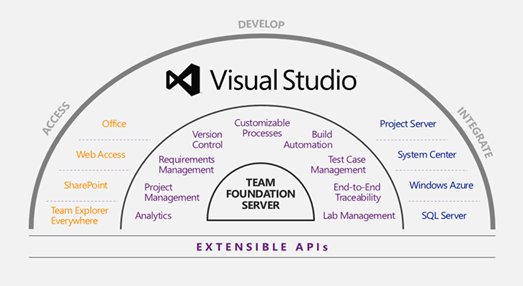So, do you know how big Visual Studio is?
Well there is Visual Studio IDE, then there is Team Foundation Server and Office integration and… well you get the picture.
Yes its a vast set of products which as academics and students you get for FREE via DreamSpark https://www.dreamspark.com
Continuous Improvement
Additionally we have now adopted a continuous delivery schedule of both the Visual Studio IDE and Team Foundation Server to continuous delivery with a 3 monthly cadence. Yes, that means that you should now be upgrading your Team Foundation Server every Quarter and that your developers should be updating their client. Before you all shout yes we know this is issue for managed desktop estates so… You know what… they don’t have to upgrade huge services packs in addition to windows updates, VS updates are now a “patch” that just updates your install.
With the move to continuous improvement and service delivery comes many problems that need solving. Like any continuous service improvement programme these may create new problem but rather than fix them, and like real world examples these raise a number of important learning issues which are vital for the modern IT professional and developer to understand and work out benefits vs risks.
For example students should be continually asking the following questions in relations to their exercises and assignments.
- How to deploy with minimal production impact?
- How to update the database without hours of down time?
- How to update different components of our application on different cadences?
- What if I update one and not the other?
If you solve these problems not only will you be able to deliver more frequently, but what you will deliver will be in smaller chucks and therefore at a significantly lower risk. Not only that, in solving your deployment problems and essentially continuously practicing them you minimise the risk of delivering to production any significant issues or problems. The result is happy consumers…
So what has Microsoft doing about this
Just 3 months after RTM and barely 6 weeks after the Visual Studio 2012 launch the first quarterly update, Visual Studio 2012 Update 1, became available and planning for Visual Studio 2012 Update 2 started.With the launch of Visual Studio Team Foundation Service the Team Foundation Server team, arguably responsible for the most complex component of Visual Studio are delivering even more frequently.
The summary is:
- Team Foundation Service updates every 3 weeks
- Visual Studio Client updates quarterly
They are effectively on a 3 week Sprint cycle and are delivering new features to production every three weeks as well as hotfixes every Monday if needed. So for more keep an eye on Brian Harry Blog site see https://blogs.msdn.com/b/bharry

